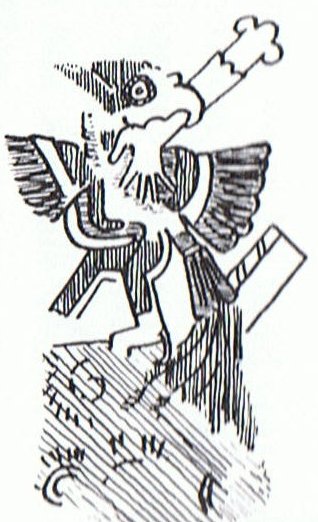3. Equipped with the concept of adjuncts, we can now return to tagata.
Tagata rima aueue has great gaps in his outline - not much of value left at all. He is only the 'wreck of a man'. He has 2 limbs with gaps, his arm at left (in the past) and also his throat. It means he has not only perished (by loosing his head) but also lost his right arm (we assume he should have been looking at us if he had been able to). A man with full integrity should have 5 ('fire') limbs, but tagata rima aueue has only 3. His head has been 'lost in translation' in the process of regeneration:
... Presented the drink to quaff, he refused it, saying that he was ill; but urged to taste it from the tip of his finger, he did so and was immediately overpowered by its magic. He lifted the bowl and was drunk. He sent for Quetzalpetlatl, his sister, who dwelt on the Mountain Nonoalco. She came, and her brother gave her the bowl, so that she too was drunk. And with all reason forgotten, the two that night neither said prayers nor went to the bath, but sank asleep together on the floor ... His right arm could have been severed half a year earlier, at midsummer. According to myth his right forearm was taken by Seven Macaw:
(Kelley, Deciphering the Maya Script.) Seven, once again, refers to the week, and the location could be at viri in Aa5-7 ('fire' and its limit). Counted from Ab1-1 the ordinal number is 1004, where 100 could be a sign of Spring Sun (Mars) - in a calendar which measures time in Moon quarters and where she takes 2 but Sun has only 1.
To maintain the established order I have to write *1004 instead of 1004 (which would have meant 1004 glyphs counted from Aa1-1). It may be a coincidence but if we count the ordinal number of Ga1-29 as 472 + 30 = 502, then it is half 1004:
The little gap at the back in Aa5-7 seems to severe the top arm (the 'cap') from the bottom arm(the 'cup'). The inside form of the 'cap' is oriented straight up, although the 'cup' renders the illusion that it is toppling forward. If its spine is cut, then it will fall on its face. Which glyph in Tahua is at ordinal number 502 counted from Ab1-1? We just have to look:
Light is in front according to the crescent behind vero in position *502. Maybe it arrives with 'the man without legs', Rogo facing forward (in order to make place for an open-in-front adjunct). Furthermore, the following tapa mea has strong feather beams in front and its body form in front is hardly bent at all. It is a day of Mercury, the little weak one. |
|||||||||||||||||||||||||||||||||||||||||||||||||||||||||||||||||||||||||||||||||||||||||||||||









